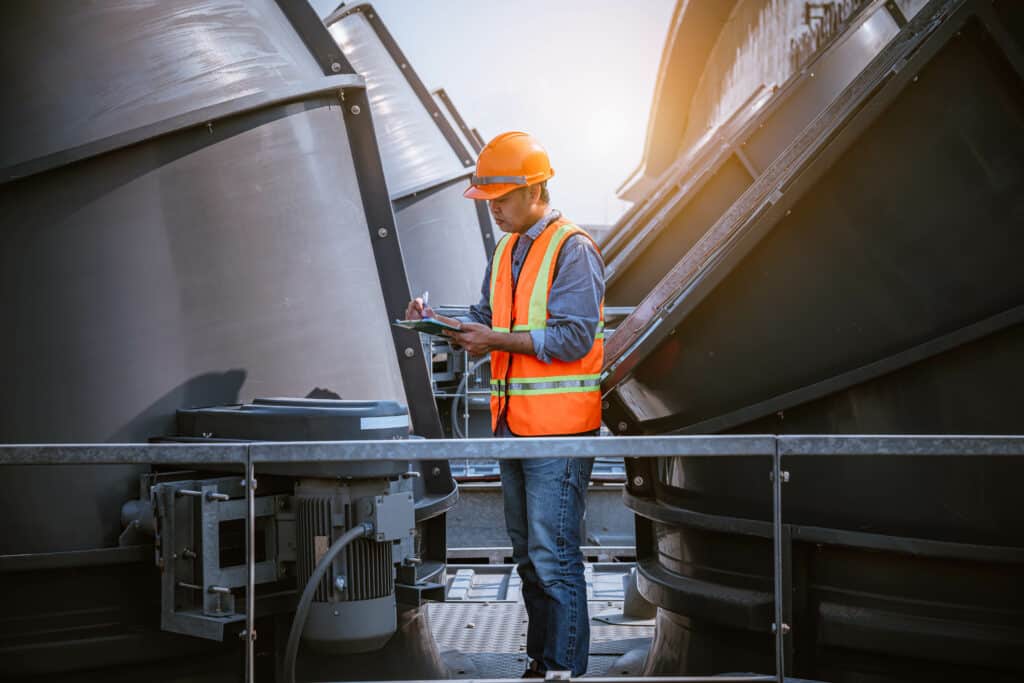Industrial Chillers, Uncategorized
The Chiller Condenser Explained
When it comes to cooling systems, chillers are the workhorses that keep industries running smoothly and maintain comfortable environments. At the heart of every chiller lies a crucial component known as the condenser.
In this blog, learn the ins and outs of the chiller condenser, its types, working principles, key components, and the factors that influence its performance.
How Chillers Work—A Brief Overview
Before understanding how a condenser works, here’s a quick refresher on how chillers work. A chiller is a thermodynamic refrigeration system designed to remove heat from a liquid and transfer it elsewhere, thereby cooling the liquid or the surrounding environment.
It follows a cyclic process involving four main steps: evaporation, compression, condensation, and expansion.
What Is a Chiller Condenser?
The chiller condenser assumes a pivotal role within the intricate framework of the refrigeration cycle. It’s responsible for the removal of heat from the high-pressure, high-temperature refrigerant vapor.
Functioning as a fundamental heat exchanger, the condenser proficiently facilitates the phase transition of the refrigerant, effectuating its condensation back into a liquid state, thereby rendering it ready for seamless integration into the subsequent cycle.
The efficacy of the condenser directly influences the overall performance and efficiency of the chiller system, making it an indispensable element in the realm of industrial cooling and thermal management.
Types of Condensers
There are three main types of chiller condensers commonly used in various applications:
1. Air-Cooled Condenser
Air-cooled condensers utilize ambient air to cool and condense the refrigerant vapor. They are generally equipped with coils and fans to aid in heat transfer. Air-cooled condensers are suitable for locations where water availability is limited or costly, and they are easy to install and maintain.
2. Water-Cooled Condenser
Water-cooled condensers, as the name suggests, use water as the principal cooling medium for the refrigerant. They typically have a shell-and-tube design that allows for efficient heat exchange with water.
These condensers are often preferred for larger chiller systems, where water resources are abundant and energy efficiency is a priority.
3. Evaporative Condenser
Evaporative condensers combine the principles of air and water cooling. They have a coil system that is sprayed with water, and the heat transfer occurs as the water evaporates.
This process significantly enhances condensation efficiency, which makes them suitable for high-temperature environments or where water conservation is crucial.
The Working Principles of a Chiller Condenser
The chiller condenser operates on the principle of heat transfer, specifically condensation and heat rejection:
Condensation Process
When the high-pressure, high-temperature refrigerant vapor enters the condenser, it comes into contact with the cooler surface of the condenser coils. As a result, the refrigerant releases heat and changes phase back into a high-pressure liquid state.
Heat Rejection
Once the refrigerant has condensed, the chiller condenser’s fans or water flow systems help to remove the excess thermal energy generated during the compression and condensation stages. The heat is either dissipated into the ambient air (air-cooled) or transferred to a water source (water-cooled and evaporative).
Key Components and Their Functions
Several components work together to ensure the smooth operation of the chiller condenser:
1. Compressor: The compressor is responsible for raising the pressure and temperature of the refrigerant vapor, making it suitable for the condensation process.
2. Condenser Coils: These coils provide a large surface area for heat exchange between the refrigerant vapor and the cooling medium.
3. Fans (for air-cooled condensers): The fans aid in drawing air over the condenser coils, which serve to enhance heat transfer and cooling efficiency.
4. Water Flow System (for water-cooled and evaporative condensers): The water flow system facilitates efficient heat transfer from the refrigerant vapor to the water to carry away the heat.
Refrigerant Flow and Pressure Changes
As the refrigerant passes through the condenser, its state changes from a high-pressure vapor to a high-pressure liquid. The pressure drop during this process is crucial for maintaining a continuous cycle because it allows the refrigerant to enter the expansion device and return to the evaporator.
Air-Cooled Condenser
Air-cooled condensers are prevalent in various industries due to their ease of installation and relatively low maintenance requirements. They consist of coils through which the refrigerant circulates, while fans blow ambient air over these coils, and promote heat exchange and condensation.
Water-Cooled Condenser
Water-cooled condensers are efficient and ideal for larger chiller systems, where continuous access to water is available. The condenser coils are immersed in a water tank, and water circulates through these coils, which serve to absorb the heat from the refrigerant vapor and carry it away.
Evaporative Condensers
Evaporative condensers are well-suited for high-temperature environments because the combination of water and air cooling significantly boosts their heat rejection capabilities. The condenser coils are sprayed with water, and as the water evaporates, it cools the coils, thus condensing the refrigerant vapor.
Factors Affecting Chiller Condenser Performance
Several factors impact the performance of the chiller condenser, including:
1. Ambient Conditions
The ambient temperature, humidity, and airflow directly affect the efficiency of air-cooled condensers. Higher temperatures and lower airflow can reduce the cooling capacity and increase energy consumption.
2. Maintenance and Cleaning
Regular maintenance and cleaning are essential to keep the condenser coils free from dirt, debris, and scaling. Dirty coils can hinder heat transfer and decrease chiller efficiency.
3. Proper Sizing and Selection
Choosing the right type and size of condenser based on the chiller’s capacity and application is crucial to ensure optimal performance and energy efficiency.
Choose from the Highest Quality Chillers with KKT Chillers
At KKT Chillers, we offer a wide range of chillers that are designed to provide optimum performance and energy efficiency. Our products undergo stringent quality checks and are tested for durability and reliability. Contact us today to receive a quote for a chiller that’s right for your industry.
